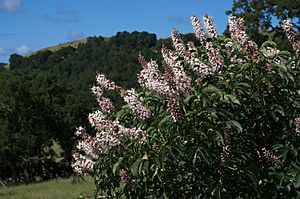California buckeye facts for kids
Quick facts for kids Aesculus californica |
|
|---|---|
 |
|
| Scientific classification | |
 |
|
| Natural range |
The California buckeye (scientific name: Aesculus californica) is a special type of buckeye tree. It grows naturally in California and the southwestern part of Oregon. It's also known as the California horse-chestnut.
Contents
About the California Buckeye
The California buckeye is a large deciduous shrub or a small tree. "Deciduous" means it loses its leaves every year. It can grow between 13 to 39 feet (4 to 12 meters) tall. Its bark is usually gray and often covered with lichens and mosses.
Most California buckeye trees have many trunks. Their leafy tops, called crowns, are often as wide as they are tall. These trees can live a long time, usually between 250 to 280 years, and sometimes even up to 300 years!
Leaves and Flowers
The leaves are dark green and shaped like a hand with five (sometimes seven) leaflets. Each leaflet is about 2.5 to 6.5 inches (6 to 17 cm) long. They have tiny teeth along their edges and feel soft, especially in spring. The leaves are delicate. They can get damaged by late spring frosts or snow. Hot summer weather can also make them dry out.
The flowers smell sweet and are white to light pink. They grow in tall, upright clusters called panicles. These clusters are about 6 to 8 inches (15 to 20 cm) long and 2 to 3 inches (5 to 8 cm) wide.
Fruits and Seeds
The fruit of the California buckeye looks a bit like a fig. It's a capsule about 2 to 3 inches (5 to 8 cm) long. Inside, there's a large, round, orange-brown seed. These seeds are quite big, measuring about 0.8 to 2.7 inches (2 to 7 cm). They are the largest seeds of any plant that grows in cooler, non-tropical areas.
Important: The seeds of the California buckeye are poisonous.
How it Survives
The California buckeye has learned to live in its native Mediterranean climate. This climate has wet winters and dry summers. The tree grows during the wet late winter and spring. Then, it goes into a resting state, called dormancy, during the dry summer months. However, trees growing near the coast often keep their leaves until the middle of autumn.
Where the California Buckeye Grows
The California buckeye is the only type of Aesculus tree that grows naturally in the western United States. You can find it all over California. It grows along the central coast and in the lower parts of the Sierra Nevada and Cascade Range mountains. Its range also reaches into the foothills of the Siskiyou Mountains in Oregon. There's also a small group of these trees, called a disjunct population, in the Chino Hills near Chino, California.
Its Home Environment
You can find the California buckeye growing in many different places. It thrives in crowded, moist, and partly shaded canyon bottoms. It also grows on dry, sunny slopes and hilltops.
In the coastal mountains north of Big Sur, it sometimes grows alone on slopes. Other times, it mixes with trees like valley oak, Oregon oak, coast live oak, and California bay laurel. In the foothills of the Sierra Nevada, you might see California buckeye standing alone in grasslands. At middle elevations, it grows with blue oak trees. Higher up, it's found in mixed forests with black oak, gray pine, ponderosa pine, and interior live oak.
Uses and Safety Information
Native American tribes, such as the Pomo, Yokut, and Luiseño, used the poisonous nuts and seeds. They would put them in small streams to make fish dizzy. This made the fish easier to catch. The bark, leaves, and fruits contain a substance that can harm red blood cells.
Buckeye wood is also good for making a fireboard. This is a tool used with a bow drill or hand drill to start fires.
Food and Wildlife
Sometimes, Native American groups used the plant as a food source. First, they would boil and wash the toxins out of the seeds for several days. After that, they could grind the seeds into a flour or meal, similar to what they made from acorns.
The nectar and pollen from the flowers are harmful to honeybees. So, it's not a good idea to plant these trees near places where honeybees are kept. When the shoots are small and the leaves are new, they have fewer toxins. At this stage, livestock and wild animals sometimes eat them. The flowers provide a lot of nectar for many types of butterflies. Squirrels and chipmunks also eat the seeds.
Other Uses
People use the California buckeye as an ornamental plant in gardens. It's admired for its pretty leaf buds, bright green leaves, and sweet-smelling white flowers. In late summer, its leaves turn a reddish-brown. In the fall, its silver branches look very artistic.
The tree also helps to hold soil in place. This prevents erosion on hills.
What's in a Name?
The name 'Aesculus' was given by Carl Linnaeus. It comes from an old Roman name for a different type of tree, the sessile oak.
The word 'Californica' simply means 'native to California'.
See also
 In Spanish: Falso castaño de California para niños
In Spanish: Falso castaño de California para niños



